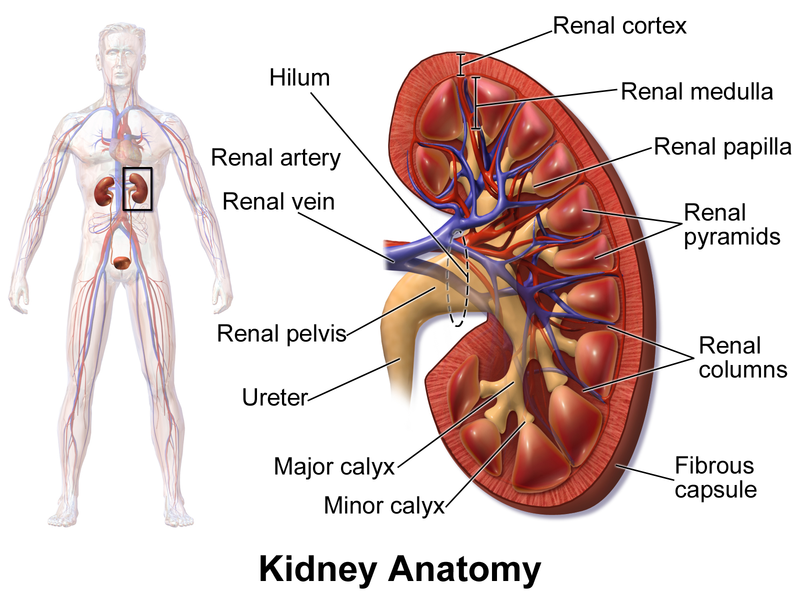The kidneys are bean-shaped organs located at the back of the abdominal cavity, one on each side of the spinal column. Most people have two kidneys and their function is to maintain the body’s chemical balance by excreting waste products and excess fluid in the form of urine.
Kidney’s Function
The kidneys filter extra water and toxins from the blood in order to control the body’s fluid balance, and keep the right levels of electrolytes. All of the blood in the body passes through them several times a day. As blood comes into the kidney, waste gets removed, and salt, water, and minerals are adjusted, if needed. The filtered blood goes back into the body. The kidneys filter about 113 to 144 litres of blood to create 0.94 to 1.8 l of urine every day.
They are not just one big filtering sponge, though. Each kidney is a system of millions of tiny filters called nephrons. A nephron has two parts. The glomerulus is the first part of the filter. It strains blood cells and large molecules from the toxins and fluid. The fluids and toxins that pass through them go through the tubule. The tubule collects minerals that the body needs and puts them back into the bloodstream and filters out more toxins.
While filtering, the kidneys produce urine to carry the toxins away. The urine is sent through two tubes called ureters down to the bladder, where the urine then leaves the body through the urethra. You could have only 10% of your kidneys working, and you may not notice any symptoms or problems. The kidneys also make hormones. These hormones help regulate blood pressure, make red blood cells and promote bone health.
If blood stops flowing into a kidney, part or all of it could die. That can lead to kidney failure.
Kidneys Conditions
- Kidney stones (nephrolithiasis): Minerals in urine form crystals (stones), which may grow large enough to block urine flow. It is considered one of the most painful conditions. Most kidney stones pass on their own, but some are too large and need to be treated.
- Nephrotic syndrome: Damage to the kidneys causes them to spill large amounts of protein into the urine. Leg swelling (oedema) may be a symptom.
- Acute renal failure (kidney failure): A sudden worsening in how well your kidneys work. Dehydration, a blockage in the urinary tract, or kidney damage can cause acute renal failure, which may be reversible.
- Chronic renal failure: A permanent partial loss of how well your kidneys work. Diabetes and high blood pressure are the most common causes.
- Diabetic nephropathy: High blood sugar from diabetes progressively damages the kidneys, eventually causing chronic kidney disease. Protein in the urine (nephrotic syndrome) may also result.
- Kidney cancer: Renal cell carcinoma is the most common cancer affecting the kidney. Smoking is the most common cause of kidney cancer.
- Interstitial nephritis: Inflammation of the connective tissue inside the kidney, often causing acute renal failure. Allergic reactions and drug side effects are the usual causes.
- Minimal change disease: A form of nephrotic syndrome in which kidney cells look almost normal under the microscope. The disease can cause significant leg swelling (oedema). Steroids are used to treat minimal change disease.
Nephrogenic diabetes insipidus: The kidneys lose the ability to concentrate the urine, usually due to a drug reaction. Although it is rarely dangerous, diabetes insipidus causes constant thirst and frequent urination.

